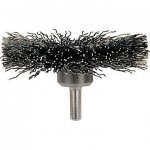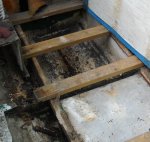I worked on rebuilding a Bayliner once (the alcohol stove exploded) and was surprised at how well it was built compared to most other boats. The guy that owned it came from the NW, he said they were very popular there.
You have to be careful you have the boat supported properly before you gut it. The stringers, bulkheads etc are the structure and support for the fiberglass, so when you take it out the hull is weak and pretty flexible. If your supports press in the hull and make bulges and humps, or it sags or twists, when you rebuild the structure, those bumps and humps etc will become permanent. Even your own weight inside the hull can distort the shape.
Rip out and discard the bulk of what you want gone and then scour the interior hull and cabin with a pressure washer. It's always better to work on stuff that is clean. Until you can't have water around because of laminating or such stuff, keep a water hose handy and when grinding, keep the area wet, to wash away the dust and to keep it from becoming air born. A wet vac is your friend. When you are all done, a few days drying will make it good for laminating or painting.
For the carpet glue, which I imagine is on the walls and ceiling....Latex porch and floor paint works real well on fiberglass. Carpet glue doesn't sand very well. Chemicals fumes are no fun in enclosed spaces. So what I have done, and recommend you do is...pressure wash it. That leaves rubbery glue blobs, carpet fur and fiberglass splinters all over. Roll on a layer of latex paint, that will solidify the glue and fur and splinters (when dry). Sandpaper usually clogs way too easily, so after the paint is dry, take a sharp paint scraper and scrape off the majority of glue/fur boogers, then hit with coarse sandpaper, 80 grit or so. Wipe it all down and then put on another coat of paint. That might be good enough, but if not, sand with some 120 grit and paint again.
That will give you an easy to clean interior for dirt cheap and it's easy to do. There will be some texture from the glass etc, but it is still easy to clean and completely smooth as far as rubbing against it etc.





















